Chamomile and Lavender for Calming Obsessive Body Image Thoughts
Introduction
For many people living with Body Dysmorphic Disorder (BDD), calm is not the natural state of mind. Even during quiet moments, intrusive thoughts about appearance can surge—relentless, circular, and emotionally draining. The inner dialogue becomes a storm: “Do I look normal? What if everyone notices? Why can’t I stop thinking about it?”
These obsessive body image thoughts aren’t simply a lack of confidence; they’re the product of a dysregulated nervous system and imbalanced brain chemistry. The body lives in a state of high alert, and the mind loops through anxiety-based self-analysis. Over time, this chronic overactivation exhausts both the brain and body.
While therapy, mindfulness, and medication are often essential tools, nature also offers gentle allies that help the nervous system relax and the mind soften its grip. Among the most effective are two timeless herbs: chamomile and lavender.
Both are known for their calming effects, but their benefits go far deeper than relaxation—they actively modulate neurotransmitters, soothe inflammation, and restore balance to the body’s stress response. When used consistently, chamomile and lavender can help break the cycle of rumination, emotional tension, and sleeplessness that fuels obsessive thinking in BDD.
Looking for supplements for This? Click here.
Understanding Obsessive Body Image Thoughts 🧠
In Body Dysmorphic Disorder, intrusive thoughts about appearance dominate mental space. A person might spend hours checking mirrors, comparing themselves to others, or analyzing perceived flaws.
These thoughts are obsessions—repetitive, unwanted, and distressing ideas that feel impossible to control. They often trigger compulsive behaviors (like mirror checking or reassurance seeking), which momentarily relieve anxiety but reinforce the loop in the long run.
Neuroscientifically, BDD is linked to:
Hyperactivity in the visual processing centers of the brain (focusing on details rather than the whole).
Imbalance in serotonin and GABA, neurotransmitters that regulate mood and anxiety.
Overactivation of the amygdala, which processes fear and social threat.
This combination creates a heightened state of tension—where even minor imperfections can feel catastrophic. Herbal nervines like chamomile and lavender help calm this overstimulated circuitry, restoring the body’s ability to relax and disengage from mental spirals.
The Nervous System and the “Stress Loop” 🔄

When you’re constantly analyzing your appearance, the body interprets it as danger. The sympathetic nervous system activates, releasing cortisol and adrenaline. Muscles tense, breathing quickens, and the heart races—even if you’re just looking in a mirror.
Over time, this stress loop becomes self-sustaining:
You think about your body.
The thought triggers anxiety.
Anxiety increases physiological stress.
The brain interprets that stress as proof that “something is wrong.”
The loop starts again.
Breaking this cycle requires both mental retraining (therapy) and physiological relaxation (nervous system support). That’s where chamomile and lavender come in—they help deactivate the stress response and reestablish a sense of safety in the body.
Chamomile: The Nervous System’s Gentle Whisper 🌼
Chamomile (Matricaria recutita) is one of the most ancient and well-studied herbs for relaxation, known for its gentle but profound effects on anxiety, sleep, and digestion.
Its name comes from the Greek “chamai” (on the ground) and “melon” (apple), referring to its apple-like scent and calming properties. For centuries, chamomile tea has been used to quiet the mind, soothe the stomach, and invite rest—three things that people with BDD often struggle with.
How Chamomile Works 🧬
Chamomile’s key active compounds—apigenin, bisabolol, and chamazulene—interact directly with neurotransmitter systems involved in anxiety regulation.
Apigenin binds to GABA-A receptors, the same calming pathway targeted by medications like benzodiazepines. This promotes relaxation without sedation or dependency.
Bisabolol and chamazulene reduce inflammation and oxidative stress, which often accompany chronic anxiety and low mood.
Chamomile also lowers cortisol levels, helping the body exit “fight-or-flight” mode.
Essentially, chamomile tells the nervous system: “You are safe now.”
Looking for supplements for This? Click here.
Benefits for People with BDD 🌿
For someone living with constant self-criticism and anxiety, chamomile offers both mental and physical relief:
Eases nervous tension and restlessness—helping you feel more at ease in your body.
Reduces obsessive thought intensity by activating GABA and serotonin pathways.
Improves sleep quality, which stabilizes mood and resilience.
Soothes digestive discomfort, often worsened by anxiety.
Chamomile’s effects build with consistency. Regular use teaches the body how to relax again—something many people with BDD have forgotten.
How to Use Chamomile 🌼💧
Tea: Steep 1–2 teaspoons of dried chamomile flowers in hot water for 5–10 minutes. Drink before bed or during moments of stress.
Tincture: Take 1–2 dropperfuls (about 30–60 drops) up to three times daily.
Essential oil: Add 3–5 drops to a diffuser or warm bath for gentle aromatherapy.
Chamomile can also be paired with other nervines like lemon balm, passionflower, or lavender for deeper calm.
Lavender: The Scent of Emotional Balance 💜
Lavender (Lavandula angustifolia) is one of the most researched herbs for anxiety, sleep, and nervous system regulation. Beyond its beautiful scent, lavender has measurable effects on brain activity and hormone balance.
While chamomile soothes gently, lavender can act as both a mood stabilizer and anxiolytic—helping reduce the emotional intensity of obsessive thoughts.
How Lavender Works 🧠
Lavender influences multiple pathways that regulate stress and mood:
It enhances GABA activity, calming the overactive neurons involved in anxiety.
It modulates serotonin receptors (5-HT1A), which help balance emotional tone.
It lowers cortisol, the primary stress hormone, especially when inhaled.
It also increases alpha brain waves, associated with relaxation and meditative states.
These combined effects make lavender a whole-body tranquilizer—not in a numbing way, but by restoring harmony to overstimulated neural circuits.
Benefits for BDD 🌿💜
For people who feel trapped in cycles of rumination and self-criticism, lavender can help slow the mental tempo and restore calm clarity.
Reduces intrusive thoughts: Lavender’s GABAergic effects help quiet overactive mental chatter.
Promotes emotional equilibrium: It eases mood swings triggered by self-image distress.
Improves sleep quality: Restful sleep allows for better emotional processing.
Eases muscle tension and rapid heartbeat: By calming the sympathetic nervous system.
Studies show that both inhaled lavender essential oil and oral lavender extract (like Silexan) significantly reduce generalized anxiety, comparable to mild anti-anxiety medications—but without dependency or side effects.
How to Use Lavender 💜💧
Aromatherapy: Inhale directly from the bottle, diffuse 4–6 drops, or add to a warm bath.
Tea: Combine 1 teaspoon dried lavender buds with chamomile for a soothing infusion.
Essential oil (topical): Dilute a few drops in a carrier oil and apply to wrists or temples.
Capsules: Use standardized extracts like Silexan (80 mg daily) for consistent anxiety relief.
Lavender works beautifully in combination with chamomile—one grounds the body, the other uplifts the mind.
Chamomile + Lavender: The Synergy of Stillness 🌿💫
When combined, chamomile and lavender create a synergistic blend that targets both the physiological and emotional layers of anxiety.
Chamomile soothes the body; lavender clears the mind. Together, they provide full-spectrum relief for obsessive thought patterns.
Chamomile: Calms the stomach, muscles, and cortisol response.
Lavender: Balances mood and quiets overthinking.
Both herbs enhance GABA and serotonin signaling, gently steering the nervous system away from fear and toward relaxation.
Imagine the experience of a cup of tea before bed—a quiet ritual that tells your body it’s time to let go. Over time, these signals rewire the brain to associate calmness with safety, rather than anxiety.
The Role of Ritual in Recovery ☕🕯️
When healing from BDD, it’s not just about what you take—it’s about how you take it. Herbal rituals slow the mind and engage the senses, bringing you back to the present moment.
Try this simple nightly practice:
Brew chamomile and lavender tea.
Sit somewhere comfortable and notice the warmth of the cup in your hands.
Breathe deeply, inhaling the floral aroma.
With each sip, silently repeat: “I am safe in my body.”
This repetitive pairing of sensory calm and positive affirmation helps overwrite anxious conditioning. Over weeks, it becomes a somatic anchor—a reliable signal of peace.
How Herbal Calming Supports Cognitive Healing 🧘
Cognitive Behavioral Therapy (CBT) and mindfulness-based approaches are cornerstones of BDD treatment. Yet, it’s difficult to engage with these practices when the mind is flooded with anxiety.
Chamomile and lavender help create the mental stillness necessary for insight to emerge. By lowering physiological arousal, they make it easier to:
Observe thoughts without reacting.
Challenge distorted body perceptions.
Stay grounded during emotional triggers.
Essentially, herbs provide the neurochemical foundation for mindfulness—helping you stay in the moment without being hijacked by fear or shame.
The Science Behind Calm: Cortisol, GABA, and Serotonin ⚖️
Modern research confirms that both chamomile and lavender influence key biological systems tied to anxiety and obsessive thinking.
Cortisol: Chronic stress keeps cortisol high, which increases inflammation and worsens body image anxiety. Both herbs lower cortisol, especially when taken consistently.
GABA: This neurotransmitter acts like the brain’s “brake pedal.” Low GABA levels are linked to intrusive thoughts and hyperarousal. Chamomile and lavender enhance GABA binding, leading to calmer, slower thought patterns.
Serotonin: Balanced serotonin supports mood stability and positive self-perception. Both herbs influence serotonin receptors, indirectly lifting mood.
By supporting these three systems, chamomile and lavender help restore neurochemical harmony—making emotional balance possible again.
Complementary Support: Pairing with Nutrition and Lifestyle 🌸
Herbs work best when supported by daily habits that nourish the nervous system. For those healing from BDD, consider incorporating:
Magnesium: Supports relaxation and complements chamomile’s calming effect.
Omega-3 fatty acids: Improve serotonin function and reduce inflammation.
B-complex vitamins: Support neurotransmitter synthesis and energy stability.
Mindful movement: Gentle yoga or walking helps integrate calm into the body.
Digital hygiene: Reducing social media exposure helps minimize comparison triggers.
When the body feels safe and well-fed, the mind becomes less reactive—allowing herbs like chamomile and lavender to work even more effectively.
Looking for supplements for This? Click here.
When Obsessive Thoughts Arise: A Chamomile–Lavender Grounding Practice 🌿💜
The next time obsessive thoughts start to spiral, try this grounding technique:
Pause and breathe. Inhale deeply through your nose for 4 counts, hold for 4, exhale for 6.
Smell lavender oil or drink chamomile tea. Let the aroma remind your nervous system it’s safe to relax.
Name what you’re feeling. “This is anxiety. This is stress.” Naming emotions engages the prefrontal cortex, shifting you out of reaction.
Touch something physical. Place your hand over your heart or hold the cup—reminding your body you’re here, not trapped in your thoughts.
Over time, your brain learns that obsessive thoughts don’t have to dictate your state of being—you can meet them with softness instead of panic.
Potential Side Effects and Safety 🌼💜
Both chamomile and lavender are considered safe for most people. However:
Chamomile may cause allergic reactions in those sensitive to the daisy family (ragweed, marigold).
Lavender essential oil should always be diluted before applying to skin.
Avoid internal use of essential oils unless under professional supervision.
If you’re pregnant, nursing, or taking medications for anxiety or depression, consult your doctor first.
Used responsibly, these herbs are gentle enough for daily, long-term use.
Integrating Chamomile and Lavender into a Healing Lifestyle 🌿
Recovery from BDD isn’t linear—it’s a journey of re-learning how to feel safe in your body. Chamomile and lavender support that journey by soothing the physiological roots of anxiety, allowing the mind to rest.
Here are simple ways to weave them into your day:
Morning: Start with lavender aromatherapy or a few drops on your wrists.
Afternoon: Sip chamomile tea during stressful moments or breaks.
Evening: Diffuse lavender or use a chamomile-lavender bath soak before sleep.
Before therapy: Take a few calming breaths while inhaling lavender—helping you enter sessions with more openness and less fear.
Small, consistent rituals create large emotional shifts over time.
Why Calm Is Revolutionary in BDD Healing 💫
Many people with BDD feel that they must fix themselves before they can rest. But rest is not a reward—it’s a requirement for healing.
When you allow your body to enter a calm state, you begin teaching your brain that safety is possible even in discomfort. Herbs like chamomile and lavender make this practice easier by reducing the physical noise—the racing heart, tense shoulders, and spiraling thoughts.
They don’t erase the challenges of BDD, but they create enough peace to face them with compassion.
And that is where healing truly begins—not in perfection, but in presence.
Final Thoughts: Reclaiming Calm, One Breath at a Time 🌿💛
Chamomile and lavender are reminders that healing doesn’t have to be harsh or complicated. Sometimes, it’s as simple as making tea, lighting a candle, and breathing deeply.
These plants reconnect us to nature’s rhythm—to a slower, steadier way of being. They teach the body how to relax and remind the mind that not every thought requires action.
In a world that constantly demands improvement, chamomile and lavender offer something radical: the permission to pause.
Because peace isn’t found in the mirror—it’s grown within the nervous system, one quiet moment at a time. 🌼💜
Looking for online therapy ? Click Here.
References 📚
Amsterdam, J. D., et al. (2009). Chamomile (Matricaria recutita) may have antidepressant activity in anxious depression. Alternative Therapies in Health and Medicine.
Kasper, S., et al. (2010). Silexan, an orally administered lavender oil preparation, effective in generalized anxiety disorder. International Journal of Neuropsychopharmacology.
Srivastava, J. K., et al. (2010). Chamomile: A herbal medicine of the past with bright future. Molecular Medicine Reports.
Cavanagh, H. M. A., & Wilkinson, J. M. (2002). Biological activities of lavender essential oil. Phytotherapy Research.
Perry, N., et al. (2012). Lavender and the nervous system. Evidence-Based Complementary and Alternative Medicine.
McKay, D. L., & Blumberg, J. B. (2006). A review of the bioactivity and potential health benefits of chamomile tea. Phytotherapy Research.
Woelk, H., & Schläfke, S. (2010). A multicenter, double-blind trial of lavender oil preparation in anxiety disorders. Phytomedicine.
Keefe, J. R., et al. (2018). Complementary and integrative approaches to anxiety management. Current Psychiatry Reports.
Posadzki, P., & Watson, L. (2015). Herbal medicines in anxiety disorders: A systematic review. Human Psychopharmacology: Clinical and Experimental.
Scuteri, D., et al. (2019). Role of natural remedies in neuropsychiatric disorders: Evidence from chamomile and lavender. Frontiers in Pharmacology.
Related Posts
-
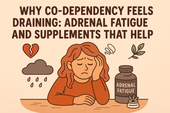
Why Co-Dependency Feels Draining: Adrenal Fatigue and Supplements That Help
The adrenal glands are small but powerful organs that sit above your kidneys, acting as your body’s built-in stress managers. They produce hormones like cortisol and adrenaline that help regulate energy, mood, and resilience. When they’re overworked from chronic stress or emotional exhaustion, fatigue and imbalance follow. Supporting adrenal health naturally can help restore calm, energy, and hormonal balance. 🌿⚡
-

The Link Between Anxiety, Co-Dependency, and Natural Support
Anxiety feels like living in constant alert mode—your heart races, your thoughts loop, and your body can’t find peace. It’s the nervous system’s way of preparing for danger, even when none exists. Understanding what’s happening in your mind and body is the first step toward calming the storm and restoring balance. 🌿💫
-
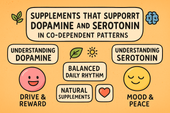
Supplements That Support Dopamine and Serotonin in Co-Dependent Patterns
Serotonin is the neurotransmitter of calm, confidence, and contentment. When it’s balanced, you feel peaceful and emotionally grounded. When it’s low, anxiety, mood swings, and emotional dependence take over. By understanding serotonin’s role in emotional health—and how to support it naturally—you can rebuild inner stability, improve relationships, and cultivate lasting happiness from within. 🌞💫
-

How Emotional Exhaustion in Codependency Impacts the Nervous System
The nervous system is the body’s communication network, connecting the brain to every organ and muscle. It regulates stress, mood, and emotion through a delicate balance of electrical and chemical signals. When overwhelmed, it can become dysregulated—leading to fatigue, anxiety, and emotional imbalance. Understanding how to calm and strengthen the nervous system is key to healing from chronic stress and emotional burnout. ⚡🌿
-
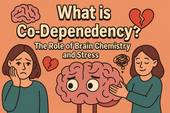
What Is Co-Dependency? The Role of Brain Chemistry and Stress
Stress is more than a feeling—it’s a full-body experience that begins in the brain and ripples through every cell. When cortisol surges and the nervous system stays on alert, your body can’t rest or recover. Over time, this constant tension affects energy, focus, mood, and even immune health. Understanding stress chemistry is the first step toward breaking free from burnout and finding calm again. 🌿
-

Creating a Supplement Stack for Motivation, Energy, and Anti-Procrastination
Motivation is the fuel behind every meaningful achievement—but it’s not just about willpower. It’s a mix of mindset, brain chemistry, and momentum. When energy, focus, and purpose align, action feels natural instead of forced. Learn how to harness motivation as a daily state, not a fleeting feeling.
-
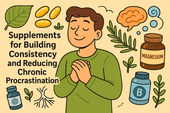
Supplements for Building Consistency and Reducing Chronic Procrastination
Biochemistry is the bridge between biology and chemistry—the science of life at the molecular level. It explains how nutrients, hormones, and neurotransmitters interact to create energy, thought, and emotion. From brain function to muscle movement, biochemistry reveals the invisible processes that sustain health, balance, and vitality.
-
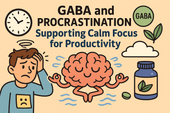
GABA and Procrastination: Supporting Calm Focus for Productivity
GABA is the brain’s natural calming messenger—a neurotransmitter that helps slow mental overactivity and ease stress. When GABA levels drop, focus fades, anxiety rises, and procrastination becomes more likely. By supporting GABA through nutrition, lifestyle, and supplements, you can restore calm clarity, improve focus, and take action with steady, balanced energy.
-
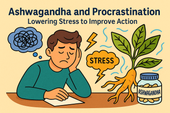
Ashwagandha and Procrastination: Lowering Stress to Improve Action
Science is the language of curiosity and discovery. It helps us understand the hidden patterns behind life, energy, and the universe. Through experimentation and critical thinking, science connects imagination to evidence—turning questions into knowledge. Whether through microscopes, molecules, or minds at work, science represents our endless pursuit of truth and innovation.
-

Neurotransmitters and Motivation: Supplements That Support Drive and Focus
Supplements can do more than boost physical health—they can also enhance mental clarity, focus, and motivation. Nutrients like omega-3s, magnesium, B vitamins, and adaptogens help balance neurotransmitters, stabilize mood, and support brain energy. When combined with good sleep, nutrition, and mindful habits, they can transform how your brain performs under stress.
-

How Stress Hormones Like Cortisol Fuel Procrastination (and What Helps)
Blood sugar isn’t just about physical health—it directly impacts focus, mood, and motivation. When glucose levels spike and crash, energy and attention do the same, fueling procrastination and brain fog. Learning how to stabilize blood sugar through balanced meals, mindful habits, and key nutrients helps keep your mind steady, focused, and ready to act.
-
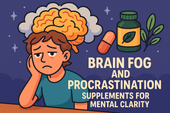
Brain Fog and Procrastination: Supplements for Mental Clarity
Brain fog can turn even simple tasks into mental hurdles. When your thoughts feel slow and unclear, procrastination often follows—making focus and productivity seem impossible. This article explores the biochemical and lifestyle causes of brain fog and reveals the most effective supplements for restoring mental clarity, focus, and sustained energy.
-

The Link Between Low Energy and Procrastination: Can Supplements Help?
Neurochemistry shapes how we think, feel, and act. When neurotransmitters like dopamine, serotonin, and GABA fall out of balance, it can lead to fatigue, anxiety, or lack of motivation—fueling procrastination and low mood. Understanding the brain’s chemical communication system helps us find ways to restore focus, calm, and emotional stability through nutrition, mindfulness, and targeted supplements.
-
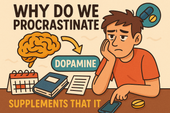
Why Do We Procrastinate? The Role of Dopamine and Supplements That Support It
Dopamine is the brain’s motivation messenger—the chemical that fuels focus, reward, and drive. When dopamine levels drop, even simple tasks can feel impossible to start. This article explores how dopamine shapes procrastination, motivation, and mental energy, along with natural supplements and daily habits that help restore balance and get things done.
-
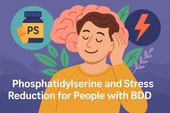
Phosphatidylserine and Stress Reduction for People with BDD
Stress is more than a mental state—it’s a full-body experience that affects hormones, brain chemistry, and emotional balance. For people with Body Dysmorphic Disorder (BDD), constant tension and worry about appearance can overload the nervous system. Learning how stress works and finding ways to calm it is key to breaking the cycle of anxiety and self-criticism.
-

How Antioxidants Like Vitamin C & E Support Mental Health in BDD
Antioxidants are the body’s natural defense against stress and inflammation. For people with Body Dysmorphic Disorder (BDD), oxidative stress can worsen fatigue, anxiety, and emotional imbalance. Nutrients like Vitamin C and E help protect brain cells, boost neurotransmitter function, and support a calmer, clearer mindset—building a stronger foundation for recovery.
-
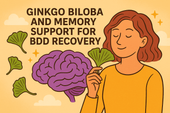
Ginkgo Biloba and Memory Support for BDD Recovery
Emotional regulation is the foundation of healing from Body Dysmorphic Disorder (BDD). When the nervous system stays in constant overdrive, even small stressors can trigger self-critical spirals. Learning to calm emotional reactivity helps restore clarity, confidence, and a sense of inner balance. By blending mindfulness, nervous system support, and self-compassion, you can retrain your brain to respond—not react—to emotion.
-

Alpha GPC and Cognitive Function in Body Dysmorphic Disorder
Mental fatigue can feel like your brain has hit a wall—thoughts slow down, focus fades, and motivation disappears. For people with Body Dysmorphic Disorder (BDD), chronic overthinking, emotional stress, and constant self-evaluation can deplete mental energy even further. Understanding what causes this cognitive exhaustion is the first step toward recovery—through rest, balanced nutrition, and targeted brain-supporting supplements.
-
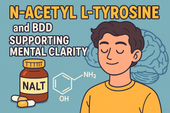
N-Acetyl L-Tyrosine and BDD: Supporting Mental Clarity
Chronic stress doesn’t just affect your mood—it reshapes your brain chemistry, weakens focus, and fuels the obsessive thought loops common in Body Dysmorphic Disorder (BDD). Over time, constant cortisol elevation drains mental energy and emotional balance. Learning to recognize and manage chronic stress is essential to restoring mental clarity, self-compassion, and resilience.
-
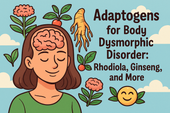
Adaptogens for Body Dysmorphic Disorder: Rhodiola, Ginseng, and More
Rhodiola rosea, often called the “golden root,” is an adaptogenic herb renowned for boosting stress resilience and mental endurance. For individuals with Body Dysmorphic Disorder (BDD), Rhodiola may help reduce fatigue, regulate cortisol, and enhance emotional balance. By supporting both mind and body, this powerful plant promotes calm focus, improved mood, and renewed energy to face daily challenges.
-
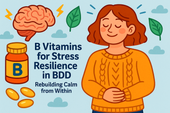
B Vitamins for Stress Resilience in BDD: Rebuilding Calm from Within
Biochemistry is at the heart of every thought, emotion, and reaction we experience. In Body Dysmorphic Disorder (BDD), chemical imbalances in neurotransmitters like serotonin, dopamine, and GABA can amplify stress and distort self-perception. Understanding the biochemistry behind mood and stress regulation offers a path toward healing—bridging the gap between emotional experience and the body’s molecular balance.
-
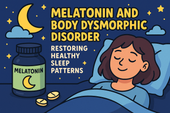
Melatonin and Body Dysmorphic Disorder: Restoring Healthy Sleep Patterns
Melatonin, the body’s natural sleep hormone, plays a vital role in helping people with Body Dysmorphic Disorder (BDD) restore healthy sleep cycles. When anxiety and obsessive thinking interfere with rest, melatonin levels often drop, leading to more emotional reactivity and distorted self-perception. This article explores how melatonin works, why BDD disrupts it, and how natural supplementation—combined with mindful routines—can help the brain and body finally find calm at night.
-
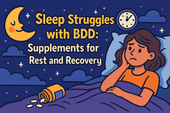
Sleep Struggles with BDD: Supplements for Rest and Recovery
When you’re living with Body Dysmorphic Disorder (BDD), restful sleep can feel impossible—but the right supplements can help reset your body’s natural rhythm. From magnesium and L-theanine to 5-HTP and ashwagandha, these nutrients support relaxation, lower cortisol, and enhance melatonin production. This article explores how supplements can calm the mind, ease nighttime anxiety, and promote true restorative sleep for emotional and physical recovery.
-
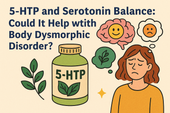
5-HTP and Serotonin Balance: Could It Help with Body Dysmorphic Disorder?
Anxiety can feel like a storm inside the mind—restless, overwhelming, and hard to control. In people with Body Dysmorphic Disorder (BDD), anxiety often fuels obsessive thoughts and self-criticism, creating a painful cycle of worry and self-doubt. This article explores the biological roots of anxiety, the role of neurotransmitters like serotonin and GABA, and how natural strategies such as mindfulness, supplements, and nervous system regulation can restore calm and mental clarity.
-
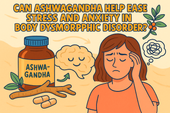
Can Ashwagandha Help Ease Stress and Anxiety in Body Dysmorphic Disorder?
Neurotransmitters like serotonin, dopamine, GABA, and acetylcholine are the chemical messengers that shape how we think, feel, and react to stress. In Body Dysmorphic Disorder (BDD), imbalances in these neurotransmitters can amplify anxiety, obsessive thinking, and emotional distress. This article explores how restoring healthy brain chemistry through nutrition, supplements, and mindfulness can help bring clarity, calm, and emotional stability.
-
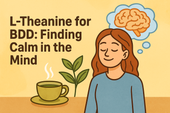
L-Theanine for BDD: Finding Calm in the Mind
Neurochemistry plays a central role in how we think, feel, and see ourselves. For those living with Body Dysmorphic Disorder (BDD), imbalances in neurotransmitters like serotonin, dopamine, and GABA can intensify anxiety, obsessive thoughts, and emotional distress. This article explores how regulating brain chemistry through supplements, mindfulness, and lifestyle changes can bring the nervous system back into harmony and restore inner calm.
-

Omega-3 Fatty Acids and Body Image Disorders: Supporting Emotional Health
Omega-3 fatty acids do far more than support heart health—they nourish the brain, stabilize mood, and may ease the emotional turbulence tied to body image disorders like BDD. This in-depth article explores how omega-3s regulate serotonin, dopamine, and inflammation, helping individuals reduce obsessive thoughts and rebuild self-acceptance. It also connects nutrition to therapy, mindfulness, and nervous system balance for holistic emotional healing.
-
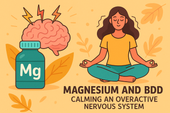
Magnesium and BDD: Calming an Overactive Nervous System
Magnesium plays a crucial role in calming an overactive nervous system—something people with Body Dysmorphic Disorder (BDD) struggle with daily. This article explores how magnesium supports relaxation, emotional regulation, and stress reduction while diving into the science behind its connection to brain chemistry. It also examines how combining magnesium supplementation with therapy and breathwork can help rebalance the body’s stress response, reduce obsessive thought patterns, and promote lasting nervous system calm.
-
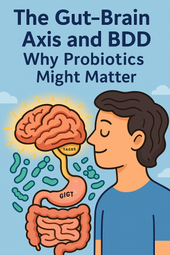
The Gut-Brain Axis and BDD: Why Probiotics Might Matter
The gut and brain are constantly in conversation — and that dialogue may shape how you experience Body Dysmorphic Disorder. By nurturing your microbiome with probiotics, prebiotics, and gut-healing nutrients, you can help rebalance serotonin, calm anxiety, and restore emotional stability from within 🧠🦠.
-
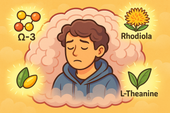
Brain Fog and Body Dysmorphic Disorder: Can Nootropic Supplements Help?
Brain fog often accompanies Body Dysmorphic Disorder, clouding focus and deepening emotional fatigue. Nootropic supplements like L-theanine, Rhodiola, and CoQ10 can help restore mental clarity, balance neurotransmitters, and bring calm energy back to the mind 🌿🧠.
-
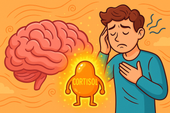
How Stress Hormones Like Cortisol May Worsen Body Dysmorphic Disorder
Chronic stress floods the brain with cortisol — the hormone that keeps you on high alert. In Body Dysmorphic Disorder, this chemical overdrive fuels anxiety, distorts self-image, and traps the body in survival mode. Calming cortisol helps restore both peace and perspective 🌿🧠.
-
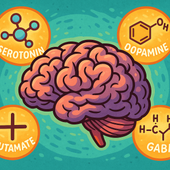
The Role of Neurotransmitters in BDD—and How Supplements May Help
Neurotransmitters like serotonin, dopamine, glutamate, and GABA shape how people with Body Dysmorphic Disorder perceive themselves. When these brain messengers fall out of balance, perception distorts — but targeted supplements can help restore calm, focus, and emotional regulation 🧠🌿.
-

What Is Body Dysmorphic Disorder? A Deeper Look at the Mind-Body Connection
Body Dysmorphic Disorder (BDD) isn’t just about appearance — it’s about perception. When brain chemistry, trauma, and stress distort self-image, the mind begins to see flaws that aren’t truly there. Healing starts by calming the nervous system and reconnecting mind and body 🪞🧠.
-

Keeping Calm in Competitive Sports: How to Train Your Mind, Body, and Chemistry for Peak Performance
Competitive pressure can overwhelm even the strongest athletes — but calm is trainable. By combining supplements like magnesium, L-theanine, and adaptogens with breathwork and mindset training, you can stay focused, balanced, and in control under any level of stress 🧠🏅.
-
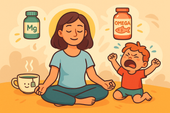
Supplements for Parents Facing Toddler Tantrums: Staying Calm When Little Emotions Run Wild
Toddler tantrums can drain even the most loving parent — but your calm is powerful. With the right supplements like magnesium, L-theanine, and ashwagandha supporting your nervous system, you can stay patient, grounded, and kind, even when emotions run high 🧸🌿.
-

Workplace Stress and Anger Management Support
Workplace stress can quickly turn into frustration — but calm is a skill you can train. By combining supplements like magnesium, L-theanine, and adaptogens with breathwork and mindset tools, you can stay focused, patient, and emotionally grounded no matter how intense the office gets 💼🌿.
-

How to Stay Patient With Family During Stressful Holidays
Holiday gatherings can stir up old stress and test your patience — but calm is possible. With nervous system support from magnesium, L-theanine, and adaptogens, plus mindful breathing and clear boundaries, you can stay centered, kind, and grounded even when family chaos unfolds 🎄💞.
-

Supplements to Keep Calm During Traffic Jams
Getting stuck in traffic doesn’t have to ruin your mood. With calming supplements like magnesium, L-theanine, and ashwagandha, you can train your body to stay relaxed and focused behind the wheel — turning gridlock into a moment of grounded patience 🚗🌿.
-
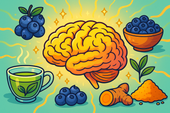
The Role of Antioxidants in Healing Brain Stress from Dissociation
Antioxidants protect the brain from the oxidative stress caused by trauma and dissociation. By neutralizing free radicals and supporting mitochondrial recovery, they help restore clarity, focus, and emotional balance — allowing the mind to heal at the cellular level 🌿🧠.
-
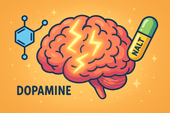
N-Acetyl L-Tyrosine (NALT) for Supporting Mental Clarity
N-Acetyl L-Tyrosine (NALT) fuels dopamine production — the neurotransmitter of focus and motivation. By supporting brain chemistry during stress, NALT helps restore mental clarity, energy, and alertness, making it easier to think clearly and feel present again ⚡🧠.
-

How Ginseng May Improve Focus and Energy in Dissociation
Ginseng helps combat the mental fatigue and fog that often come with dissociation. By supporting mitochondrial energy, balancing neurotransmitters, and regulating cortisol, it gently restores focus, motivation, and emotional presence — helping the mind reconnect with clarity and strength 🌿⚡.
-
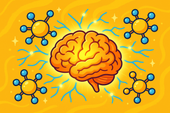
Phosphatidylserine and Dissociation: Supporting Cognitive Function
Phosphatidylserine helps calm the stress response by balancing cortisol, the body’s primary stress hormone. By lowering cortisol spikes, it protects memory, focus, and emotional stability — restoring clarity and mental presence for those struggling with dissociation 🧠🌿.
-
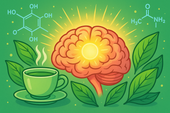
Can Green Tea Extract Help with Dissociative Brain Fog?
Green tea extract may help lift dissociative brain fog by supporting neurotransmitter balance, reducing inflammation, and enhancing energy at the cellular level. With its key compounds EGCG and L-theanine, it promotes calm focus, clarity, and emotional presence — helping you feel more alert and grounded 🍵🧠.
-
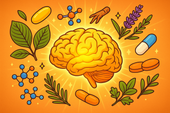
Building a Natural Supplement Stack for Dissociation Support
Building a supplement stack for dissociation means nourishing the brain and body back into communication. By supporting neurotransmitters, gut health, and energy balance through nutrients like magnesium, omega-3s, curcumin, and probiotics, you can help restore clarity, calm, and connection — one layer at a time 🌿🧠.
-
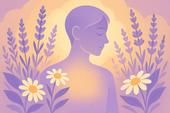
Chamomile and Lavender for Dissociative Anxiety Relief
Chamomile and lavender work together to calm dissociative anxiety by soothing the nervous system and restoring emotional safety. Their natural compounds balance cortisol, enhance GABA activity, and activate the vagus nerve — helping you feel grounded, connected, and at peace again 🌿💜.
-
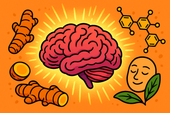
Curcumin for Inflammation and Mental Clarity in Dissociation
Curcumin, the golden compound in turmeric, does more than fight inflammation — it helps clear the mental fog often tied to dissociation. By calming neuroinflammation, balancing neurotransmitters, and supporting mitochondrial energy, curcumin can restore mental clarity, focus, and emotional presence 🌿🧠.
-
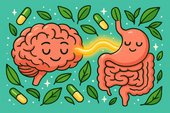
Probiotics and Dissociation: Exploring the Gut–Brain Axis
The gut–brain axis plays a vital role in emotional awareness and presence. When the microbiome is balanced, it supports serotonin production, vagus nerve activity, and calm focus. Probiotics help repair this connection — restoring safety, clarity, and the feeling of truly being in your body again 🌿🧠.
-
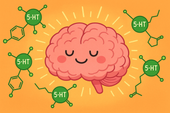
5-HTP for Dissociation: Supporting Serotonin and Emotional Stability
5-HTP helps bridge the gap between emotional numbness and stability by supporting serotonin production — the neurotransmitter that shapes mood, sleep, and sensory awareness. For people experiencing dissociation, 5-HTP may gently restore connection, presence, and emotional balance from the inside out 🌿🧠.
-

CoQ10 and Energy Support for People with Dissociation
Chronic dissociation often leaves the body running on empty — tired, foggy, and disconnected. CoQ10 helps recharge that system at the cellular level by restoring mitochondrial energy, reducing oxidative stress, and supporting the brain’s capacity to stay present. It’s energy medicine for both body and mind ⚡🧠.

















































